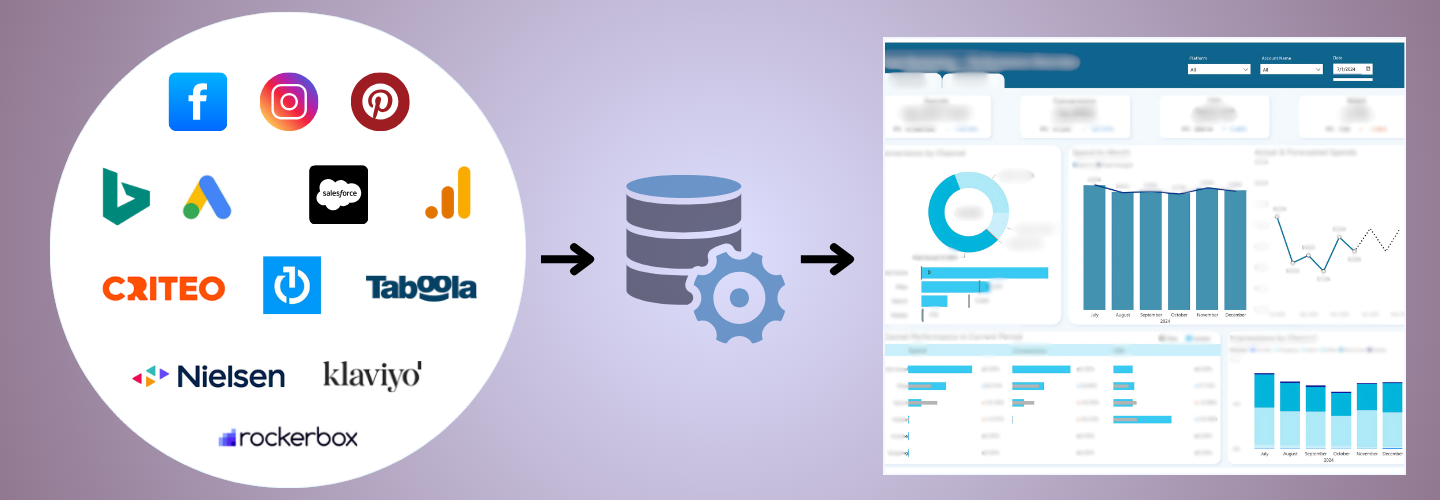In the digital marketing world,automation is the key to efficiency. Whether you're a small, medium, or
large business, automating your reporting can save hours of manual work each week, allowing you to focus more on optimizing campaigns and delivering value to your clients. However, the choice of a reporting automation tool can be overwhelming, especially when there are various options available in the market, each catering to different company sizes and needs.
This article breaks down the best digital marketing reporting tools for small, medium, and large companies, highlighting why each tool is suited for the different stages of business growth and what to consider before making a decision.
Choosing the Right Tool for Your Company Size
The right tool for your business depends largely on the size of your company, your existing infrastructure, and your reporting needs. Here, we’ll explore the features, pros, and cons of several popular reporting tools and how they align with different company sizes.
1. Google Data Studio (Looker Studio)
Best for: Small to Medium-Sized Companies
Why?
Google Data Studio is a free, user-friendly tool that integrates well with other Google services like Google Analytics, Google Ads, and YouTube. It’s an excellent choice for small businesses or even medium-sized businesses, especially if your company relies heavily on Google’s ecosystem.
Pros:
- Free to use, making it an ideal option for small businesses with limited budgets.
- Seamless integration with Google products, such as Google Ads and Google Analytics.
- Customizable dashboards that can be tailored to different reporting needs.
- User-friendly interface, making it accessible for non-technical users.
Cons:
- Limited outside of Google products: While it works well within the Google ecosystem, it has limited functionality when integrating with non-Google platforms.
- Not ideal for large businesses: As the business grows, Google Data Studio may struggle to handle complex datasets or provide the advanced features needed by large enterprises.
Conclusion:
Google Data Studio is perfect for small businesses using Google products, as it’s free, easy to use, and doesn’t require heavy investment. It’s also suitable for medium-sized businesses, but scalability and advanced capabilities may become a concern as the company expands.
2. Power BI
Best for: Medium to Large Companies
Why?
Power BI offers advanced reporting, data analytics, and visualization capabilities that are essential for medium-sized and large companies with complex data and reporting needs. Its deep integration with the Microsoft ecosystem makes it particularly appealing for businesses already using Office 365 and other Microsoft services.
Pros:
- Scalable: Power BI can handle large datasets and complex reports, making it suitable for growing and large businesses.
- Advanced analytics: Offers powerful data modeling, predictive analytics, and AI-powered insights.
- Multiple integrations: It can integrate with a wide variety of marketing platforms and external data sources.
Cons:
- Steep learning curve: While the basic features are accessible, mastering advanced features can be challenging for non-technical users.
- Paid tool: Power BI’s pricing might be a barrier for small companies, especially those with limited reporting needs.
Conclusion:
Power BI is an excellent choice for medium and large companies that require advanced features, scalability, and extensive integration options. However, it may be overkill for small businesses or those just getting started with digital marketing.
3. Domo
Best for: Medium to Large Companies
Why?
Domo is a powerful business intelligence tool designed to handle real-time data and integrate with a wide range of marketing platforms. It’s ideal for medium to large companies that need real-time reporting and want to consolidate data from various sources into a single platform.
Pros:
- Real-time data updates: Domo excels in providing real-time insights, which is crucial for businesses that need to adjust campaigns and strategies on the fly.
- Wide integration options: It supports numerous integrations with marketing tools and data sources, making it highly versatile.
- User-friendly interface: Despite its advanced capabilities, Domo is relatively easy to use for both technical and non-technical users.
Cons:
- Expensive: Domo is one of the more expensive options, which may not be suitable for smaller businesses or those with limited budgets.
- Complexity: Its advanced features may be too much for smaller teams or those not dealing with high volumes of data.
Conclusion:
Domo is ideal for medium and large companies that need real-time reporting and a comprehensive tool to integrate and analyze data from various marketing channels. However, its high cost and complexity may make it less suitable for small businesses or those with simpler needs.
4. Supermetrics
Best for: Small to Medium-Sized Companies
Why?
Supermetrics is a marketing-focused reporting tool that automates the collection of data from marketing platforms like Google Ads, Facebook, LinkedIn, and more. It’s a great choice for small to medium-sized companies that want to automate their reporting without diving into more complex business intelligence tools.
Pros:
- Easy integration with popular marketing platforms like Google Ads, Facebook, and LinkedIn.
- Automation-friendly: Supermetrics automates data collection, reporting, and transfers to tools like Google Sheets, Excel, and Google Data Studio.
- Affordable: Compared to full-fledged BI tools like Power BI and Tableau, Supermetrics offers a cost-effective solution for marketing teams.
Cons:
- Limited advanced reporting features: While it excels in data collection, Supermetrics lacks the deeper reporting and visualization features of more advanced BI tools.
- No complex analytics: Supermetrics is best suited for basic reporting needs and doesn’t offer deep data analysis or predictive capabilities.
Conclusion:
Supermetrics is an excellent tool for small to medium-sized businesses looking to automate the collection and reporting of marketing data. However, it may not be suitable for large companies with more complex reporting or analytical needs.
5. Tableau
Best for: Medium to Large Companies
Why?
Tableau is a leader in the data visualization and reporting space. It’s ideal for medium to large companies that require sophisticated reporting capabilities and interactive visualizations. It’s well-suited for companies with complex data sources and those that need a tool to create customized, in-depth reports.
Pros:
- Advanced data visualizations: Tableau is renowned for its ability to create interactive and visually compelling reports.
- Scalability: Can handle large datasets and complex reporting needs, making it a good fit for larger organizations.
- Wide integrations: Tableau integrates with a variety of data sources and marketing platforms, making it versatile.
Cons:
- Steep learning curve: While powerful, Tableau requires technical expertise to use effectively, particularly for users without a data analytics background.
- High cost: Tableau’s pricing model can be prohibitive for small businesses, particularly those that don’t need all of its advanced features.
Conclusion:
Tableau is perfect for medium to large businesses that require in-depth, interactive reporting and sophisticated visualizations. Its cost and complexity, however, may limit its appeal for smaller businesses.
6. HubSpot Reporting
Best for: Small Companies Using HubSpot
Why?
HubSpot Reporting is a great option for small companies that already use HubSpot for CRM and marketing automation. It offers a simple and integrated way to track marketing performance, but it’s not as flexible as other tools when it comes to integrating with external platforms.
Pros:
- All-in-one solution for companies using HubSpot’s CRM and marketing tools.
- User-friendly interface designed for non-technical users.
- Customizable reports that can be tailored to different marketing campaigns.
Cons:
- Limited integrations: HubSpot Reporting works best within the HubSpot ecosystem and lacks robust integrations with other marketing platforms.
- Not suitable for large enterprises: As businesses grow and need to track data across multiple platforms, HubSpot’s reporting capabilities may fall short.
Conclusion:
HubSpot Reporting is ideal for small businesses that already use HubSpot for CRM and marketing. However, it’s less suited for larger companies or those needing to integrate data from multiple sources outside the HubSpot ecosystem.
Suitability for Company Sizes

Key Takeaways for Different Company Sizes
Small Companies:
- Google Data Studio and Supermetrics are the best options as they are cost-effective and user-friendly, perfect for smaller teams with limited resources.
- HubSpot Reporting is a good fit if the company is already using HubSpot for CRM and marketing automation, as it integrates seamlessly with the HubSpot ecosystem.
- Power BI, Tableau, and Domo may be overkill in terms of cost and complexity for small companies that do not require advanced reporting or scalability.
Medium-Sized Companies:
- Power BI and Tableau are suitable due to their scalability, ability to handle more complex reports, and the flexibility they offer for diverse datasets.
- Supermetrics works well for medium businesses focused on automating marketing reports across multiple platforms.
- Google Data Studio can also be a viable option, especially for businesses that are heavily reliant on Google tools and require flexible yet basic reporting.
Large Companies:
- Power BI and Tableau are both excellent choices for large companies due to their ability to scale, support complex reporting, and integrate with various data sources.
- Domo is ideal for large enterprises that need real-time data and robust integration capabilities, though its high cost may be a factor to consider.
- Supermetrics can be useful for large businesses to automate data transfers from marketing platforms but may not offer the deep reporting and analytics features needed at the enterprise level.
- HubSpot Reporting is not recommended for large businesses unless they are primarily using HubSpot for marketing and CRM management.
Conclusion
Choosing the right digital marketing reporting tool depends on the size of your company and its specific needs:
- Small Companies: Google Data Studio, Supermetrics, and HubSpot Reporting are the best choices due to affordability and ease of use.
- Medium-Sized Companies: Power BI, Tableau, and Supermetrics provide the scalability and flexibility needed for more complex reporting.
- Large Companies: Power BI, Tableau, and Domo are ideal for managing complex datasets, real-time reporting needs, and advanced analytics.
By considering your company size, reporting requirements, and budget, you can select the right tool to automate your digital marketing reporting and improve your team’s overall efficiency.



